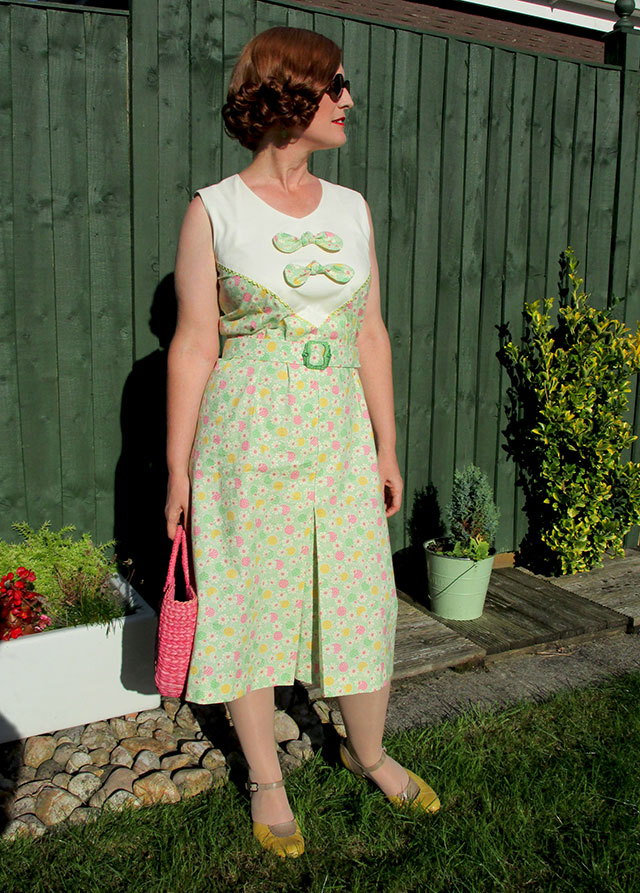
Outfit Details
1930s Dust Bowl Dress – Made by Me
Pink Wicker Handbag – Marks & Spencer (years ago!)
1930s Style Sunglasses – eBay
1930s Style Yellow Shoes – Hotter Shoes
1930s Jade Drop Earrings – Gift
The term ‘dust bowl’ comes from a period in 1930s when severe dust storms ravaged the landscape in the American and Canadian prairies. These storms created a severe drought and many farms in these regions failed to produce any crops. The first wave of storms came in 1934 at a time when every day Americans were already suffering greatly from the effects of the Depression.
Out of this devastation and poverty came a fashion known as the dust bowl dress. The style was simple, wearable but also incredibly stylish. Women used whatever they could to add interest and detail to the basic early 1930s shape and often mixed different fabrics they had scraps of. During this time producers of flour and feed realised that women were using their sack packaging to create clothing and decided to print them with very distinct patterns rather than leaving them plain.
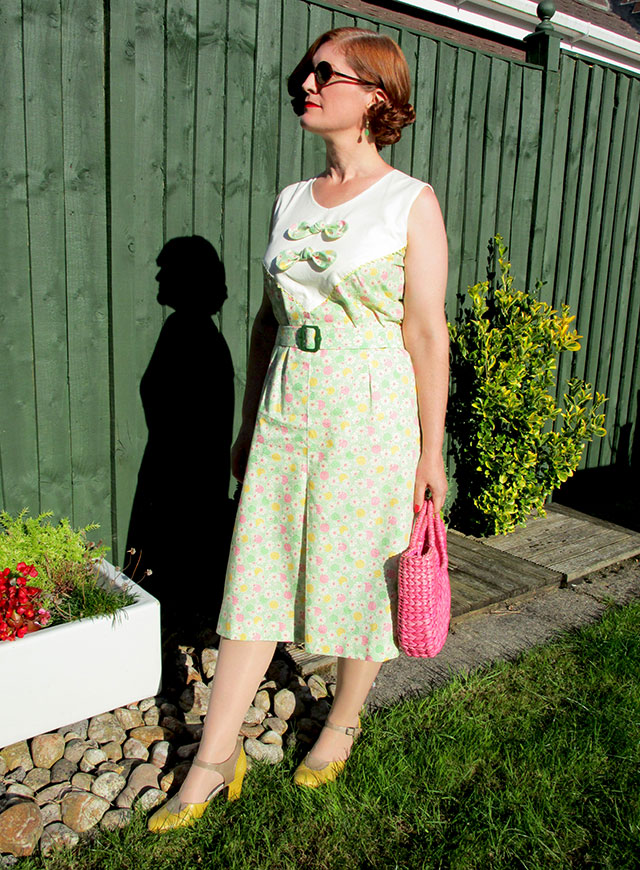
Today these prints are instantly recognisable as being from the 1930s dust bowl or Depression era. They’re often brightly coloured and have that real Art Deco feel about them. However, purchasing an original feedsack is not only costly but also almost impossible if you want to buy matching ones to make a dress. But not all is lost, there is a sector of the fabric industry that reproduces these 1930s prints and that’s the quilting cotton sector. (Quilting was huge during the 1930s and the distinct 1930s quilt was made from small scraps of feedsack fabric and matched with plain fabric.)
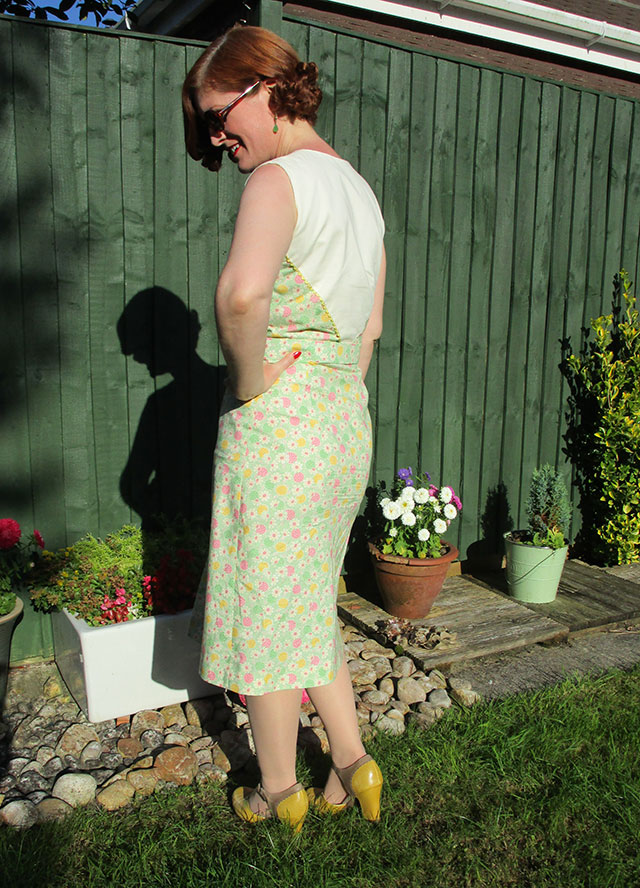
So, when I stumbled across Country Threads Patchwork in Bath whilst on a hunt for a particular wool shop, and walked into a room full of 1930s printed quilting cotton, you can probably imagine my excitement. I’d seen this type of fabric online but had never seen it in real life, so literally had no idea of the weight or feel of it. It was great to finally be able to see it and touch it for myself.
Unfortunately for me, it is quite a heavy and stiff fabric, despite being 100% cotton. It’s not ideal for 1930s dressmaking but when I spotted this absolutely amazing green, pink, yellow and cream print I just could not resist. I knew I had to try and make something from it but also knew that it was going to be a complete experiment, which could go either way.

Now this fabric isn’t cheap and it’s also not very wide, so at £13 a metre and only 110 cms wide, I chose just two metres. I knew this wasn’t going to be enough to make a whole dress, so I decided to take a leaf out of the dust bowl ladies book and match it with a plain fabric. I decided to go with quilting cotton again to make sure the weights were the same, but as it was plain it was much cheaper. I chose cream rather than any of the bright colours to make sure it really stood out.
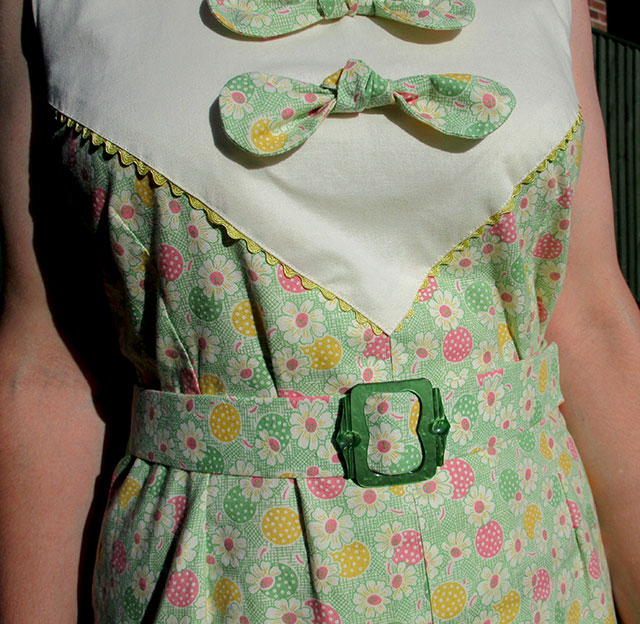
When I pinned the cream yoke onto the main fabric I thought it still looked a little bit too plain for a dust bowl dress. It needed something to go between the plain and the patterned fabric. It was common during this era to add bias binding or ric rac to define certain areas, so I went digging in all of my trimmings boxes. Eventually I pulled out yellow ric rac, bright pink ribbon and green bias binding. I spent ages trying to decide which one of them to use but in the end the yellow ric rac won out. It was from a card of different coloured ric rac scraps my mum had back in the 1970s, so it fitted the bill of just using what I had perfectly.
The buckle is an original 1930s celluloid one and again was in my stash. I did try a yellow one and a cream one but this green one was the most special and stands out perfectly against the pattern. The bows, however, are my favourite bit. They were so easy to make but look so cute. I can just imagine a lady in the 1930s making these from little scraps of feedsack and adding them to an old dress to liven it up again.
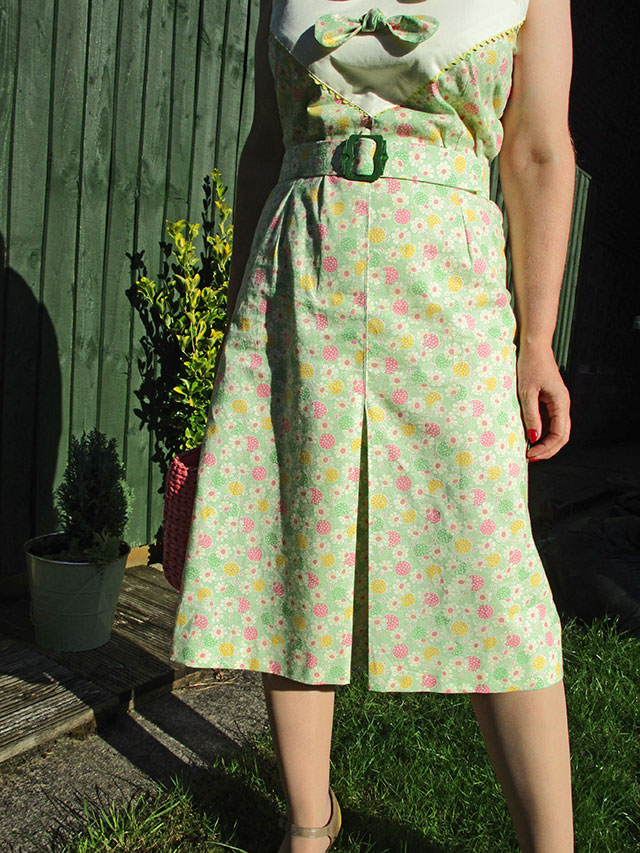
The skirt part is a 1930s classic and simple slight A-line shape with a single kick pleat in the centre. In typical 1930s fashion, the front and back of the skirt are just one piece of fabric each and the pleat is just created by top stitching the folded pieces above the knee. There’s no messing about with matching up a separate back piece to the pleat, just fold, top stitch and press. Also, there’s no waist seam line. Again, in typical 1930s fashion, it’s what they call a one-piece dress, i.e. the skirt and bodice are all in one, rather than being two separate sections you sew together.
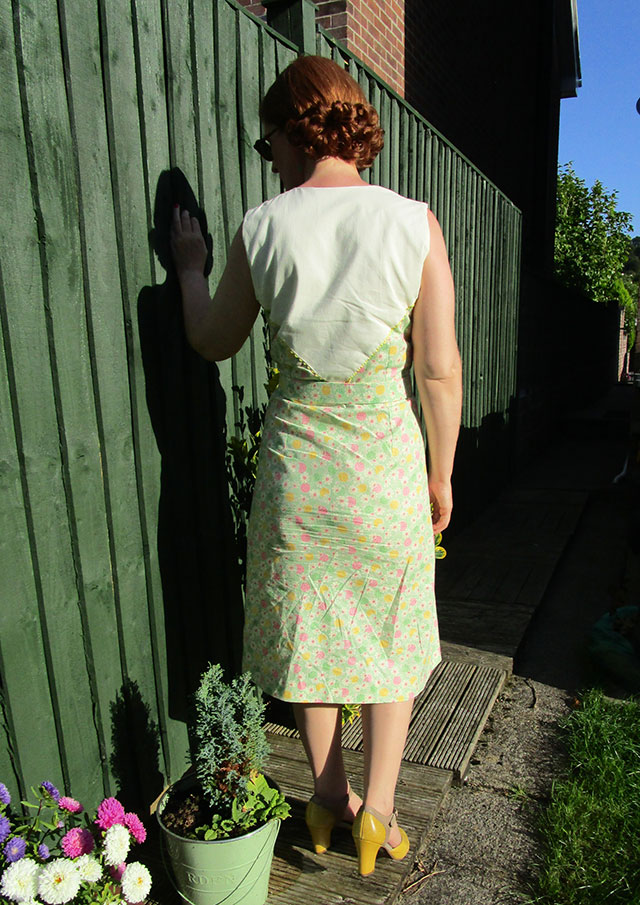
The darts on both the front and back waist areas were not part of the original pattern and you can read more about why I chose to add them here. They’re not ideal but it does mean that the shape suits me better. There’s still a little bit too much fabric around the waist line as it folds in a couple of places when the belt is pulled tight. If this had been a much softer fabric, i.e. much more of what would’ve been used back in the 1930s, then this would’ve gathered nicely around the waist and there would’ve been no need for the darts.

Despite the troubles I had with dress and the messing about with the pattern, I am sort of happy with it. I would say about 70% happy! I did get a lot of compliments when I wore it on Sunday, which did help me feel a bit better about it. And I do still looooovvvvveeeee that print!
So, what did I learn from this experiment?
- Never use quilting cotton for 1930s dresses ever again. It’s not suitable and is far stiffer than what would’ve been used originally. It could work for a skirt though.
- Always, always do a mock-up first. I was too eager with this dress and had some serious fitting issues that would’ve been ironed out at the toile stage.
- I need more casual, easy to wear dresses from the earlier 1930s because, despite the 26 degree heat, this was so comfortable to wear and I didn’t feel sticky at all.








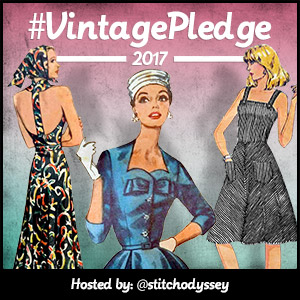
Very cute
Thank you! x
Fantastic dress! Great job 🙂 I love the pattern, you were right to take it home.
Thanks Liz! I’ve still got a little bit of the fabric left, so now I’m trying to think of how I can incorporate it into something else. It’s such a beautiful print! xx
It’s a lovely dress!
It’s a shame that these fabulous 1930s prints are not made in a lighter weight – I’ve been similarly tempted to use them in the past but the fabric really is too stiff. I guess not enough of us make our our clothes for the manufacturers to think it worthwhile to make dressmaking weight fabrics in more prints. It’s sad
Thanks Norma. Yes, I know, it’s so disappointing that it’s not available in a cotton lawn or a viscose, I know loads of people who would just snap it up. xx
The dress is really lovely, Cate, and looks so 1930s! The bows are the perfect finishing touch. I often use quilting cotton for my sewing (3 different decades including the 1930s) and have found that how well it works or not really depends on the cotton since it can vary from heavy to thin, and stiff to soft. And of course the pattern has to work with a cotton – it doesn’t drape. This one looks great!
Thanks Kristen! This fabric really was too stiff for this pattern. It probably would’ve been okay in a skirt or a lightweight jacket but for the style of the dress it needed a softer cotton. The main problem with modern cottons is the way it’s produced. Cottons from the past were much softer and had more of a hang to them because they didn’t have so many chemicals in them. It’s a shame but thankfully organic cottons are being produced in much more interesting prints than they used to be. xx
I love this dress, the fabric is gorgeous and the bows so cute! Which pattern did you use, or did you design it yourself?
I have a 1950s dress made from quilting cotton and the skirt hangs and twirls beautifully but the bodice is a little stiff around the neckline.
Thank you Anna! The pattern was from My Vintage Wish on Etsy. You can see it here – https://www.etsy.com/uk/listing/504881523/1930s-afternoon-frock-and-jacket-sewing.
I can imagine a 1950s circle skirt working really well in quilting cotton as it needs to be stiff to create the look. It’s a shame it just doesn’t work for garments that need more drape as they’re just incredible prints. xx
Like all makers you’re looking at this and seeing the flaws, whereas I looked at this and swooned over such a delectable 1930s dress (and that belt buckle!!). It may not be perfect, but I think that makes it more true to the spirit of the 1930s. I’m sure those women living in the dustbowl didn’t have perfect dresses either- like you, they were working with what they had to create an everyday version of the ideal. I think we’re a bit too prone to falling for the ‘BBC-washing’ (or maybe ‘PBS-washing’ in this case!) of historical fashions, where we get our inspiration from movies and tv shows where the costumes are all perfect and highly stylised. Which is a longwinded way of saying, that dress is gorgeous!
hehehe, thank you Kate! It doesn’t help that I’m a total perfectionist either! It’s funny you saying about BBC-washing, I’ve actually seen some costumes up close that have been used for some of the most successful shows and they do have quite a few flaws in them. The clever costume and camera people are just so good at making them look perfect on the final production. xx
its so pretty, that print is amazing and nice use of the white ‘bib’, you have styled it beautifully as always
Oh, thank you Eimear! I do like a different coloured bib, it’s such a classic 1930s detail. xx
Such a gorgeous dress – and perfect in that sunlight and perfect with those fabulous shoes. Thanks for the history too – I had no idea! Kx
Thanks Karen! Yes, I thought the blazing sun kind of went well with this dress to give it that dust bowl look. The shoes were from Hotter and actually didn’t look like that when I bought them. They had a wide t-bar between the main shoe part and the strap but I didn’t like it. I cut it off and very patiently sewed the leaving edge shut, so it didn’t fall apart! xx
I love how this dress has turned out in the end, even with all the hurdles you came across. The cream yoke with the yellow ric rac is genius and I love the bows and that fabulous belt buckle. Well done, Cate! xxx
Thank you Ann! Yes, I’m happy that it turned out as well as it did. I had expected to not like it at all about half way through the making up process. xx
Very pretty! I love the practical 1930s inspiration that you chose – it looks easy to wear and quite cute, two very important things when putting together an outfit!
Is there any way to soften up a fabric? A few cycles through the washer, maybe? (As a total non-sewer, please feel free to tell me that I have no idea what I’m talking about.)
Thank you Jessica! I’m not sure it will soften in the wash, but I have my fingers crossed that it will. It’s probably the only thing that will have any effect on the stiffness. xx
Cate – I just now came across your blog, and read about this dress and how it came about. I have been doing some online studying regarding the Depression era Feed Sack dresses, and have a Pinterest board dedicated to their “birth” and development.
Regarding the stiffness of the fabric you chose – traditional 30’s and 40’s FeedSack materials were very tightly woven cottons, with the labels of the product originally printed on in indelible inks so that potential exposure to the elements wouldn’t damage the identification of what was in the bags! A sudden cloudburst (rainstorm) that might happen to the farmer taking his purchases home in the back of an open pickup truck bed from the Feed and Seed Store, or the local Co-Op, would have erased the labels of chicken feed and Flour before he could get them home and under cover, had they been otherwise! While both are very useful items, they are hardly interchangeable!
Once the Feed and Seed and Flour and Sugar bag manufacturers became aware of frugal Depression-era farm wives’ efforts to “make it do or do without” in producing baby’s diapers, baby rompers and two piece outfits, towels, and other useful and sorely needed textiles, they decided to make their products serve a two-fold purpose, and hired fabric designers to come up with useful and attractive prints, and pattern designers to come up with apron and dress patterns which could be made up with one or two matching bags. Younger girls blouses, skirts and dresses, and little boys shirts, shorts and short overalls, as well as women’s dresses, blouses, skirt patterns, etc, were also designed to be laid out on a minimum amount of fabric from the bags. Other household items not requiring patterns, such as window curtains, dish towels, diapers, clothesline bags, etc., were also highly popular. BUT, the inking process had to change with the pattern printing process added to the mix. Nobody, no matter how attractive the overall pattern, wanted to be seen with “XXX Chicken Feed – Better Feed Makes Better Eggs!!” printed in the middle of the back of their blouse!
In any way So, the label printing process was changed, to use inks that were removed by washable methods. They didn’t come out just by a quick swish in warm water, either. Most had to be soaked out in warm or hot water and laundry soap (detergents hadn’t been developed yet – it was ALL soap flakes, or hard bar soap that needed grating to become a sort of flake before using, or even homemade lye soap for really frugal wives. After the soaking, followed by rinsing, came the regular washing. In a big tin wash tub, unless ahe was a relatively well-off farmer’s wife, and had a real washing machine run off a gasoline powered 2 stroke motor. Then through the wringer, followed by cold water rinse, followed by a close inspection to determine whether or not all the labeling ink had been removed! If not, then some more soaking might do the trick, or more washing may be needed!
In any case, all this washing and soaking, wringing, etc., would certainly play a part in softening up the fibers which were originally created and closely woven to secure the contents inside the bag. Dress making was a secondary point. There were even bags printed with the outlines of soft toys, like dolls and stuffed animals with the colors and features printed on as well, so that all you need do was to cut them out on the outside lines, turn the faces together and sew on the seam-line leaving a small opening, then turn right side out, stuff firmly or softly, depending on the child for whom it was being made, sew up the stuffing hole, and voila! A dolly, a dog, a bunny rabbit, or even a stuffed duck for baby to play with. And a perfect project for the youngster learning how to sew!
Feed sacks advanced in production methods a little later, so that the identification of the contents and the brand, etc., were printed on a stiff 8paper band so that the soaking out of the label inks was no longer necessary, but the usual washing, rinsing, wringing and drying, followed by trimming rough edges and a good ironing with a hot flat iron made the fabric ready to use! Many a farmer’s wife sent her husband or older done off to the Feed and Seed, or the local Co-op with strict instructions to not return without a few more bags of a specific pattern so that she might begin, or complete a certain project she already had started, or had in mind to start! Many’s the store owner or manager who got accustomed to those big, healthy farm boys tossing around bags of chicken mash, or flour like they were toys, looking for or digging down to the specific pattern or color they had orders from Mom not to return without!
These continued to be popular in rural communities into the 1950’s, and only fell out of favor with rural families when the cloth bag went by the wayside, in favor of the multilayered paper sacks. The 50’s were also a time of financial improvements, and the budget was no longer as tightly stretched as once was, allowing for the purchases of regular dress fabrics, and even ready made clothing! Trips to the new stores moving more closely to suburban and rural areas, or even just more generously sized purchases from the mail order catalogs became the order of the day.
Thank you for all that information. I actually wrote an article about it all myself in a complication book that’s shortly to be published. I haven’t really gone into its history very much on my blog due to there being so many other articles online that pretty much cover the subject. I’d love to see your Pinterest board about it.
So sorry! I forgot to mention how much I really do like your dress, and appreciate the amount of skill and creativity it takes to produce such a lovely garment! I really do. I used to sew quite a lot in high school, making bathing suits, among other things, for myself to fit my oddly shaped, very long-waisted body in 8th grade (about 13 – 14 years old) as well as fashionable school clothes. In the early 70’s that covered a lot of ground! Then by the time I was ready to graduate, in my Senior Year, or 12th grade, at 17- 18 years, I took on the task of making my own Senior Prom – very formal – long gown! I almost made my own wedding gown at 19, but I found one on sale, ready made by Jessica McLintock – “Gunne Sax” brand in a store selling nothing but young women’s clothing, including Prom Gowns, that just blew mine right out of the water, so to speak, for half price! I had already priced out the materials and notions/trims for the one I wanted to make, and this one was cheaper! So, I pounced on it, and was right in style for my 1976 wedding!
So, I can really appreciate the amount of work, and the creative skills it takes to do something like this.
As for being a perfectionist, we are our own worst critics to be sure, and are frequently stymied by what I like to call “analysis paralysis!” We get so focused on the tiny things that may not be perfect, that we lose track of all the big things that are right, and can’t even begin to know where to start to try and fix any of it, as if it really needs it. Right? Getting around all that is the hardest part of all!
You did extremely well on this dress, it looks adorable on you! Imagine trying to fit a 5’8″ figure, with overly long legs, “pear” shape, and long waisted by at least 3″ over and above standard pattern measurements! That was me then though.
NOW, I have shrunk by 2″ due to spinal conditions, two spine surgeries including a fusion with hardware and a bone graft. Plus, gained weight over the last 40-some years. Makes it much more challenging when sewing is no longer an option, and being on our Social Security Disability benefits doesn’t leave anything for paying seamstresses to make things for me. Cutting my previous income as a Certified Surgical Technologist (ODP-Scrub I believe is the UK equivalent)by 2/3 doesn’t leave much for “frills.” Fortunately my husband still works, but at 62, I’m not sure how much longer he can keep on working on vehicle transmissions , which is what he knows so well after over 40 years as a mechanic. His regular retirement on Social Security isn’t going to replace all his income either.
But, shrinking as I have has taken some of the strain off of fitting issues! And, being disabled as I am, I don’t go out hardly at all, except to doctor’s ⚕️ appointments and to get my ♀️hair cut. So, pajamas, robes (“dressing gowns” I think is the proper UK name for them?) and house slippers are generally the uniform of the day most of the time. That’s OK – less laundry that way!
So, very cute dress, you did well on it, and now I’m going to go look at more of your blog entries! Rock on!
Thank you! Wow, a Gunne Sax dress! They’re very sought after these days in the vintage community. They were such gorgeous dresses and so perfect of their time. I’m not surprised you chose it over making one.
Such a beautiful dress and thank you for talking about the history of ‘the dust bowl dress’.
Thank you and you’re welcome. I always think it’s important to share information like this, so everyone understands the history behind the dress. xx
This is such a cute and pretty dress. The fabric print is so cheery, perfect for a sunny day. I like the bows and the ric rac too. Looks fantastic on you. Your hair is extra specially good here too!
Aw, thank you! I’m trying to leave my hair a bit more natural after I’ve curled it and not pin it back. It worked well this day but it proved rather annoying over this last weekend. I need to figure out the best way to set it to make sure it doesn’t just keep flopping forward. xx
Even with the difficulties this dress turned out very cute! I love the belt buckle too, I really need to make a few things with the buckles I have started accumulating. I know the pain of quilting cotton very well, it’s so incredibly annoying to me that all printed cotton fabric producers seem to make is quilting cotton. Most of the fabric shops here have mountains of colorful and fun prints but only in darn quilting cotton! If they made just a fraction of the same prints in an apparel weight I, and I’m sure many other dress makers, would be so happy! I realize quilters are a huge part of the fabric market, but perhaps more people would make clothes if there were more fabrics available to them! Liberty makes lovely lighter weight cottons of course, but they are just so expensive. This subject is endlessly irritating to me obviously, ha!
It’s funny, quilting really isn’t that big here but you can find quilting cotton everywhere! With the Great British Sewing Bee dressmaking is really popular in the UK, but we rely so heavily on imported fabrics that we have no choice. It’s one of the reasons I’ve started looking at organic and UK produced fabrics. Hopefully, this will improve in the future. And yes, Liberty cotton lawns are beautiful, but I generally only ever buy them when they’re on sale! xx
What a beautiful dress you created. Did you prewash use white vinegar in the wash & fabric softener in rinse cycle? I’ve found it really helps.
Thank you! No I didn’t. I’m terrible at not washing fabric before I get started, I’m far too impatient. I’ve been dressmaking for over 20 years and have never had any major issues with not pre-washing, so I can’t see me starting any time soon 🙂
The dress looks gorgeous on you! I love the way the bows turned out! Even though you pointed out all the flaws I still can’t really see them. I’ve had the same problem before of falling in love with a quilter’s cotton print but knowing it would be too stiff for apparel. I did successfully make a blouse from quilter’s cotton, but it was very fitted so the fabric didn’t need to drape or gather.
Thank you Kate, it’s lovely to hear that you can’t see all of the flaws that I can. I’m far too much of a perfectionist and I’m never happy with anything I make! I may end up using quilting cotton again but it will only ever be for something like a skirt or a fitted blouse. xx
I can only agree with a previous comment – as the maker you can only see the flaws, whereas everyone else sees a stunning dress. I agree with you about quilting cottons though; I see all these lovely prints, and just know that they won’t work for dresses. xx
I know, it doesn’t help that I’m a perfectionist, and quite frankly never happy with anything I make! xx
Well I think this dress is a stunner! You persevered marvellously despite the issues, and it turned out fantastic! Lesson learnt here about quilting cotton – I often wondered about its suitability for dressmaking but will leave it alone! X
Aw, thank you! Quilting cotton would be fine for something like a 1950s circle skirt because it needs the stiffness in the fabric to create the sharper look, but 1930s dresses were soft and drapey, so it’s just the wrong fibre makeup to get a more period authentic look. xx
Well, it looks adorable, and I have to say that those little bows are my favourite part and up the cute factor a few points all by themselves!
Thank you Tanith! The bows were so simple to make, but yet so effective. I’m definitely going to use the pattern on something else I make in the future. xx
This fabric is adorable, so I can see why you had to use it despite it being on the heavier side! And yes-ALWAYS do a toile! Every time I don’t, I regret it bitterly! And thank you for the history of these garments. I hadn’t heard of them before. So interesting!
Yep, ALWAYS do a toile! This is probably the first time ever that I haven’t but boy, did I learn my lesson. xx
Oh boy I’m so in love with the print! I’m currently obsessed with feedsack prints at the moment but I totally agree with you on the value-for-money POV. I find that some Japanese lawn fabrics have small floral prints that are similar to feedsack prints, might be worth checking them out! xGwen
Yes, I spotted some Japanese lawn fabric on Etsy that had a 1930s feel to them. I immediately added them to my wish list but I haven’t gotten around to ordering any yet. xx